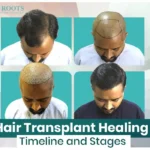Navigating FUT and FUE: Selecting the Best Hair Transplant Method for You.
Comparing FUT and FUE: Which Hair Transplant Method is Right for You?
Introduction to Hair Transplant Procedures
Hair loss is grossly distressing and traumatic – whether it is thinning of the hair, a receding hairline, or bald patches on the crown. A hair transplant is a permanent remedy to deal with hair loss and balding and to achieve a head full of hair!
Once you have decided about having a hair transplant surgery, it all comes down to scheduling and figuring out what procedure would be the most desirable and the best fit for you in accordance with your requirements and choices.
What is Hair Transplant Surgery?
Your trichologist will evaluate and consider your case; discuss your health status, figure out whether you are eligible for the procedure and understand your hair goals. He will then curate a tailor made plan for you.
Your surgeon and you need to decide between the FUE and the FUT procedures and which one would be more appropriate for you.
For the FUE, hair follicles are extracted from the donor area and inserted in to the recepient site; for the FUT, a strip of tissue is excised from the donor area, cut in to individual follicles and then implanted at the recepient site.
Once your doctor has nailed down the specifics, you will be given pre surgery mandates to follow.
Detailed Overview of FUT (Follicular Unit Transplantation)
For the FUT, the surgeon will excise a thin, long section of tissue from the donor area, i.e. the posterior part of the scalp. Individual follicles are removed from this piece of tissue via microscopic dissection and implanted in to bald patches.
Who is an Ideal Candidate for FUT?
FUT is recommended for -
- FUT is ideal for people 25 years and above. This is because, the hair loss pattern is not predictable in youngsters below 25 years.
- FUT is excellent for people who have grade 6 and 7 hair loss, wherein, you will require a big number of grafts to cover up the bald areas.
- Those who have a high follicle density benefit from FUT because they receive better coverage.
- FUT is perfect to manage a hairline that has receded considerably.
In-Depth Analysis of FUE (Follicular Unit Extraction)
The FUE is a hair restoration surgery which is minimally invasive. Hair follicles from the back of the scalp are excised as individual follicles using a punch and they are transplanted at the recipient site and inserted in to the bald areas.
Who is an Ideal Candidate for FUE?
You are an ideal candidate for FUE -
- If you have healthy hair growth on the back of the head, your perfect for FUE. The back of the head is the donor area from where the grafts are harvested.
- Being 25 years and above; given that the hair loss pattern will have stabilized by this age.
FUE vs FUT: Head-to-Head Comparison
Comparison of the Procedure Techniques
The FUE is a longer procedure, compared to the FUT. Both surgeries are completed in a day’s time, but you will sit longer in the chair if you choose the FUE. The FUE takes longer because it is an intricate and meticulous procedure wherein the doctor punches out individual hair follicles, instead removing a strip of tissue from the back of the head, making it somewhat elaborate.
Comparison of Recovery Times
The recovery time for an FUT is longer than that of an FUE. Given the fact that a thin strip of tissue is excised from the donor area; consequently the donor site takes time to heal completely. After 15 to 20 days, your doctor will remove the stitches. Complete recovery and healing of the scalp will take approximately 5 weeks.
As against this, the FUE has a shorter recovery phase. The recovery phase is about 12 to 15 days.
Comparison of Scarring
After an FUT, you are left with a visible scar. A linear scar is apparent in the donor area given that the FUT needs a linear incision and extraction of a strip of tissue. It is possible to hide the scar with surrounding long hair though. Unfortunately, you can not have short hair at the back of your head because the scar will be very obvious.
FUE is a minimally invasive procedure and is associated with absolutely no scarring. FUE excises individual hair follicles using a punch, without causing any linear scarring. The site of follicular extraction is less than 1 mm, so, scars are not visible at all.
Comparing the Risk of infections
Factors to Consider When Choosing Between FUE and FUT
When you are making a decision, make sure that you select a procedure that will be absolutely suitable for you. Discuss with your doctor, check out patient testimonials and confer with others who have had hair restoration.
With humongous developments in technology and the dexterity of surgeons, a large section of the population is looking to restore lost hair via hair transplant. Choosing the right hair transplant technique can be somewhat tricky. There are many factors to consider before you settle on a technique.
Both FUE and FUT are completely viable methods to help restore hair. It is vital that you understand the pros and cons and then make an informed decision.
Assessing Donor Hair Availability
For an FUE, your surgeon can only harvest 1 out of 5 follicles in a given area – this comes to approximately 20%. In comparison, the availability in an FUT is 100%.
Assessing the Pros and Cons
Pros for FUE
- The FUE has a way less painful and a quicker recovery phase the FUT.
- Stitches aren’t needed.
- The FUE does not leave you with any scarring.
- You can have a short hair and no scar will be visible.
- The donor area too heals very quickly.
Cons of FUE
- The FUE yields fewer hair as compared to FUT.
- FUE is more expensive than FUT.
- The back and the sides of the scalp require to be shaved.
- The FUE is a lot more time consuming compared to the FUT.
Pros for FUT
- The FUT is cheaper than the FUE.
- It is a fairly short procedure.
- You can carry out large hair transplant using more hair grafts.
- Experts recommend having an FUT first, and then follow it up with an FUE in case a second procedure is necessary.
Cons for FUT
- Stitches are needed.
- The recovery phase is long and somewhat painful.
- You are left with a visible scar.
- You need long hair to cover the scar, you can not have a short hairstyle.
Consider the Results
Both, the FUE as well as the FUT offer satisfactory results. On the other hand, if a considerable quantity of grafting is needed, then the FUT delivers better results; given that, it yields more hair. Then again, the FUT leaves a visible scar, whereas the FUE leaves you with no visible scarring.
Considering Costs
The Success rates
FAQs
If you do not have adequate hair on the back of your head or if the hair is too thin and there’s hardly any donor hair, then you aren’t a good candidate for a hair transplant. Then again, you could talk to your doctor and discuss whether body hair can be used. Those diagnosed with chronic telogen effluvium and alopecia areata, are not recommended hair transplants.
It is absolutely normal to experience hair shedding a few weeks after the hair transplant surgery; however, this is short lived and your hair will follow the normal hair growth cycle, and new hair will sprout where the follicles have been transplanted. You will not continue the pattern baldness again after the procedure because of the nature of the transplanted follicles. The hair that are transplanted are harvested from the back of the head where the hair are permanent.
Despite having a host of differences, the success rates of the FUE and FUT hair transplant techniques are fairly similar. How good the final results of your hair transplant are is more dependent on other factors – such as how well the surgeon performs the procedure and aftercare treatment – rather than which technique was used.
Your doctor may advise you to use Minoxidil or Finasteride after your hair transplant procedure in order to preserve the existing hair by decelerating the speed of hair loss. Additionally, it is always prudent to stick to a healthy meal plan and include plenty of ‘hair foods’ which will help keep your hair healthy.
Modern, trail blazing hair restoration methods promise you absolutely natural looking results. FUE treats each hair follicle individually and independently, and each graft is implanted very precisely and meticulously in to the recipient site, thereby, giving you totally natural looking hair.
Your new hairline will be noticeable immediately after the surgery! Over an interval of 3 to 6 months, there will be a gradual upswing in the growth of your hair. It will take 12 months for you to have a head full of hair!
Hair restoration surgery has improved by leaps and bounds and technology has made radical advances promising you brilliant-looking results. During an FUE, your doctor will transplant individual hair follicles, this ensures that you do not have unnatural looking hair that the people in the 70s and 80s had to live with! Doctors today, artistically and skilfully design the hairline and strategically implant the grafts to proffer a natural look.
FUE as well as FUT are conducted under local anaesthesia, so there’s no pain at all during the surgery. Once the effects of the anesthesia wear off, you will feel soreness and discomfort in your scalp. Given that, the FUT involves excising a strip of tissue, the soreness will be more and it is likely to stay for longer compared to the FUE.
After a hair transplant procedure, you should stay at home for at least 7 – 10 days. This is the recovery phase and healing correctly during this time is very vital. After 7 to 10 days, you will have recovered completely and the signs of inflammation won’t be apparent anymore. What’s more, the transplanted grafts take about a fortnight to get anchored firmly in to the scalp and exercising absolute care and caution are exceedingly crucial during this phase.
When an FUT is carried out, a strip of tissue is excised from the donor site and the edges of the wound are sewn together, leaving behind a thin, linear scar. The scar is apparent if you tend to wear your hair really short; long hair will mask the scar completely.
If you have already had an FUT and are planning another one, the previous scar is removed when the next donor strip is extracted. Consequently, you are left with only one linear scar, irrespective of how many FUTs you have.
After an FUE, minuscule, dot scars are left behind which are absolutely invisible. As a result, this makes FUE a very popular option for those who wear their hair very short. Conversely, if you wish to have a second FUE, the tiny scars from the next surgery get added to the scars from the previous surgery. The scars are then a little apparent. Furthermore, the scarring distorts the adjacent follicles and makes the next FUE very difficult.




